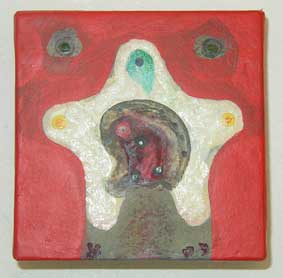Yuhei Yoneya a vu le jour à Taiwan, qu’il quitte avec sa famille neuf ans plus tard, retournant à Sapporo. Passer de la belle île (ihla formosa) tropicale et cultivée à la froide Hokkaido, l’île du Nord qui, en dépit de sa situation, a été un genre d’«Australie » des Japonais depuis l’époque Edo, et où la culture indigène Aïnou a presque disparu, c’est un écart qui éclaire le travail de peinture de Yuhei Yoneya et son engagement dans les mouvements avant-gardistes de Sapporo.
Assez tôt, les références explicites ont disparu de sa peinture, qui s’est alors construite dans des sortes de limbes de la culture. Les éléments visibles, précis, semblent remonter à un « avant » de la figure, qui nous renseigne -peut-être- sur les véritables éléments de quoi la culture s’est constituée avant de s’épanouir en mythes, en règles et en mœurs. Cette recherche de Yoneya s’est enrichie de la connaissance de l’Inde, puis des archipels Ryu-Kyu (Okinawa), puis d’un regain d’intérêt pour l’influence bouddhiste au sein de la culture japonaise. La notion de « bön » et de « ga » trouve alors une place très curieuse dans sa peinture qui, moins méditative, devient ludique et presque luxuriante.
(texte en japonais)
米谷雄平
米谷雄平は台湾で生れ、9歳で家族と共に札幌に戻った。先住民族のアイヌ文化が殆ど,消滅 しつつある、江戸時代以来,日本の「オーストラリア」とも言える、北の島である寒い北海道 に対し、南国の美しい島での日々は、米谷雄平の制作活動と札幌での前衛芸術運動の中に関わ りながら、明確に現れている。
米谷雄平の絵画は、早いうちから、他と参照となるものは消滅し、文化という聖域の中から構 築されていく。神話、習わし、風習から、開花された以前の、築き上げられた文化とは何かと いう真実の要素を、我々に表現以前に遡らせ、この問いに対し、明白な可視をさせるように思 える。
この米谷の探求は、インドを知ることで、そして琉球列島(沖縄)さらに日本文化の中核にあ る仏教の影響への関心に至り、彼の制作を多彩に展開していく。
「梵:我」の観念は、あまり瞑想的ではなく、現実感があり、想像力をかきたてられる彼の絵 画の中で、特異な位置づけとして見出される。
Galerie SATELLITE ブリュノー メゾン 2003


Yuhei YONEYA “South point “









Yoneya Yuhei was born in Taiwan, and left at nine with his family going back to Sapporo. Taiwan (Formose, after the portugeese ihla formosa, beautiful island) is a tropical island under the influence of Chineese culture. Hokkaido is cold, quite unfriendly, the native Aïnou culture has almost vanished; it has been some kind of an « Australia » for the Japaneese since the Edo era, dispite it is located in the north. This gap might help understanding Yoneya’s paintings and his involvement in artistic avant-garde mouvements of Sapporo.
Realistic references disapeared soon enough from his painting, dealing then with something like culture in limbo, with precise visual elements that seem to go back before the image; this might tell us a bit about what stuff the culture did build itself with, before its blossom of myths, arts and rules.
Yoneya’s quest got deeper with his knowledge of India, of the Ryu-Kyu archipelagos (Okinawa), and a renewing interest in the Buddhist influence at the core of the Japaneese culture. The Buddhist notion of « bön » and « ga » find an amazing form in his painting, which became less severe, even playful and luxuriant.
The panoramic painings here named “South point” are related to the undersea world.
South point. h = 25 cm
Les ensembles intitulés “South point” sont des peintures panoramiques, elles se réfèrent en partie au monde sous-marin.
Etoiloïdes, h = 10 cm

|
Les-basics-nfrance.com
PHP, Mysql, 20 POPS, Webmail hébergement web à partir de 0.83 EUR / mois. |
